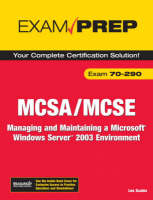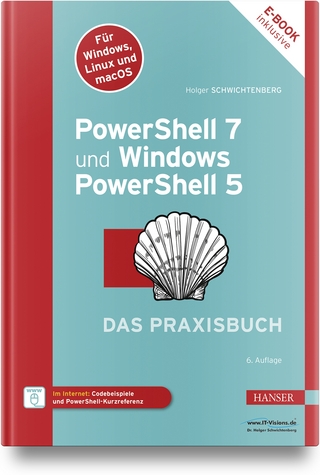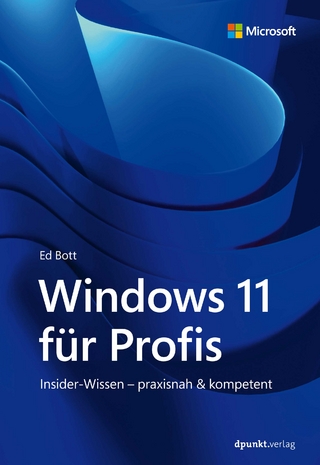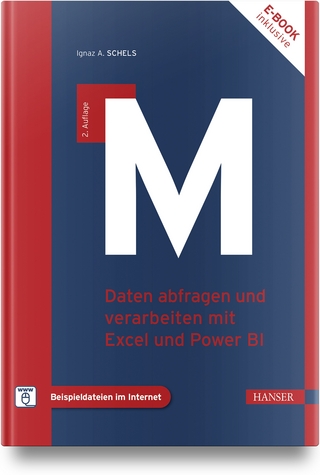
MCSA/MCSE 70-290 Exam Prep
Pearson IT Certification (Verlag)
978-0-7897-3648-2 (ISBN)
- Titel ist leider vergriffen;
keine Neuauflage - Artikel merken
&>
Managing and Maintaining a Microsoft® Windows Server™ 2003 Environment
Your Complete Certification Solution!
Exam 70-290
Lee Scales
The Smart Way to Study™
In This Book You’ll Learn How To
Implement and manage local and network resources
Manage files and folders
Implement, manage, monitor, and troubleshoot hardware devices
Implement, manage, monitor, and troubleshoot disk quotas
Implement, manage, monitor, and troubleshoot Print Monitor
Monitor and optimize system performance
Implement and manage group policy
Manage and implement disaster recovery
Manage users, computers, and groups
Implement and manage a software update infrastructure
WRITTEN BY A LEADING 70-290 EXAM EXPERT!
Lee Scales, BSEE, MCSE (NT/W2K/W2K3), has worked in the computer industry for more than 25 years, including stints with IBM and Microsoft. He is employed as a senior network consultant with Levi, Ray & Shoup, Inc., of Overland Park, Kansas. In addition to his consulting duties, he has developed courseware for the Windows platform for several years and has contributed as an author to titles in the Exam Cram series and to a number of websites.
See the Inside Back Cover for Exclusive Access to 70-290 Practice Questions and Simulations!
Helps you identify your strengths and weaknesses, so you can assess your readiness to take the actual 70-290 exam.
Provides detailed explanations of correct and incorrect answers.
Features a variety of study modes, so you can work your way through the questions in the manner that best suits your study preferences.
Covers each 70-290 exam objective.
Lee Scales holds the MCSE+I (NT4) as well as the MCSE (W2K/W2K3) certifications and has been working in the computer industry for more than 25 years, including employment and consulting engagements with several Fortune 100 companies. He is currently employed as a senior consultant with a Microsoft Gold Partner, where his duties include working with companies that are migrating to the Windows Server 2003 platform with Active Directory. In addition to his consulting duties, he has been developing courseware for the Windows platform for several years and has been a contributing author and coauthor to titles in the original Exam Cram, Exam Cram 2, and Windows Power Toolkit series. When time allows, he also contributes articles to various technical magazines and websites. When not buried neck deep in a networking project, Lee enjoys camping, hunting, and fishing, especially in places where you can't plug in a laptop and where the cell phone doesn't work. Lee lives in Overland Park, Kansas with his son, Davin, and daughter, Alayanna. You can reach Lee at leescales@hotmail.com.
Introduction
Part I: Exam Preparation
Chapter 1: Windows Server 2003 Environment
Introduction
The Windows Server 2003 Family
Windows Server 2003 Standard Edition
Windows Server 2003 Enterprise Edition
Windows Server 2003 Web Edition
Windows Server 2003 Datacenter Edition
Windows Server 2003 Enterprise Edition for 64-Bit Processors
Service Pack 1
Windows Server 2003 R2
Installing Windows Server 2003
Hardware Requirements
Hardware Compatibility
The Real World
Getting Started
Logging On to Windows Server 2003
Servers and Their Roles
Windows Server 2003 Administrative Tools
Installing the Administrative Tools
The Microsoft Management Console: Where Management Begins
Chapter Summary
Key Terms
Apply Your Knowledge
Exercises
Exam Questions
Answers to Exam Questions
Suggested Readings and Resources
Chapter 2: Managing User and Computer Accounts
Introduction
Creating and Managing User Accounts
Creating and Modifying Local User Accounts
Creating and Modifying User Accounts Using Active Directory Users and Computers
Logging On to a Windows Server 2003 Domain Controller
Using the Active Directory Users and Computers Console
Creating Accounts Using Automation
Troubleshooting User Accounts
Using Saved Queries
Managing Local, Roaming, and Mandatory User Profiles
Creating and Modifying Local User Profiles
Creating and Modifying Roaming User Profiles
Creating and Enforcing Mandatory User Profiles
Creating and Managing Computer Accounts in an Active Directory Environment
Creating Computer Accounts Using the Active Directory Users and Computers Console
Creating Computer Accounts by Joining the Domain
Troubleshooting Computer Accounts
Troubleshooting Issues Related to Computer Accounts by Using the Active Directory Users and Computers Console
Chapter Summary
Key Terms
Apply Your Knowledge
Exercises
Exam Questions
Answers to Exam Questions
Suggested Readings and Resources
Chapter 3: Managing Groups
Introduction
Creating and Managing Groups
The Four Domain Functional Levels
The Three Forest Functional Levels
Group Type
Group Scope
Default Groups
Creating and Modifying Groups by Using the Active Directory Users and Computers Console
Identifying and Modifying the Scope of a Group
Managing Group Membership
Finding Domain Groups in Which a User Is a Member
Creating and Modifying Groups by Using Automation
Assigning Groups
Chapter Summary
Key Terms
Apply Your Knowledge
Exercises
Exam Questions
Answers to Exam Questions
Suggested Readings and Resources
Chapter 4: Managing and Maintaining Access to Resources
Introduction
Configuring File System Permissions
Configuring and Managing Shared Folders
Creating and Managing Shared Folders
Managing Shared Folder Permissions
Connecting to Shared Folders
Configuring and Managing NTFS File and Folder Permissions
Managing Permissions Inheritance
Changing Ownership of Files and Folders
Verifying Effective Permissions When Granting Permissions
Copying and Moving Files and Folders
Combining Share and NTFS Permissions
Troubleshooting Access to Files and Shared Folders
Managing Access to Shared Files Using Offline Caching
Managing Internet Information Services (IIS) 6.0
Installing Internet Information Services (IIS)
Reliability
Management
Managing Security for IIS
Chapter Summary
Key Terms
Apply Your Knowledge
Exercises
Exam Questions
Answers to Exam Questions
Suggested Readings and Resources
Chapter 5: Administering Windows Server 2003
Introduction
Managing Servers Remotely
The Microsoft Management Console: Where Management Begins
Administrative Groups
Remote Desktop for Administration
Remote Assistance
Managing a Server Using RunAs
Managing and Administering Software Site Licensing
Licensing Applet
Licensing Utility
License Groups
Chapter Summary
Key Terms
Apply Your Knowledge
Exercises
Exam Questions
Answers to Exam Questions
Suggested Readings and Resources
Chapter 6: Implementing Printing
Introduction
Printing with Windows Server 2003
The Windows Server 2003 Print Architecture
Print Clients in Windows Server 2003
Adding Printers in Windows Server 2003
Network-Attached Printers
Print Servers
Publishing a Printer in Active Directory
Searching for Printers in Active Directory
Printer Settings and Configurations
Managing Print Drivers
Chapter Summary
Key Terms
Apply Your Knowledge
Exercises
Exam Questions
Answers to Exam Questions
Suggested Readings and Resources
Chapter 7: Managing Printing
Introduction
Printing with Windows Server 2003
Working with the Print Spooler
Assigning Print Permissions
Scheduling Printer Availability
Setting Printer Priority
Managing Printing in Windows Server 2003 R2
Installing the Print Management Console
Using Printer Filters
Troubleshooting Printing Problems
Chapter Summary
Key Terms
Apply Your Knowledge
Exercises
Exam Questions
Answers to Exam Questions
Suggested Readings and Resources
Chapter 8: Managing Access to Objects in Organizational Units
Introduction
Organizational Unit Overview
Modifying Permissions for Objects in an OU
Security Descriptors
Permissions
Assigning Permissions to Active Directory Objects
Permissions Inheritance
Moving AD Objects
Effective Permissions
Delegating Control of an OU
Chapter Summary
Key Terms
Apply Your Knowledge
Exercises
Exam Questions
Answers to Exam Questions
Suggested Readings and Resources
Chapter 9: Implementing Group Policy
Introduction
Group Policy Overview
Refreshing Group Policy
Implementing Local Group Policy Objects
Implementing Group Policy Objects in a Domain
Managing Policy Objects
Linking GPOs
Default Group Policy Objects
Group Policy Inheritance
Blocking Group Policy Inheritance
Enforcing Group Policy
Group Policy Management Console
Group Policy Filtering
Chapter Summary
Key Terms
Apply Your Knowledge
Exercises
Exam Questions
Answers to Exam Questions
Suggested Readings and Resources
Chapter 10: Managing the User Environment by Using Group Policy
Introduction
Assigning Scripts with Group Policy
Benefits of GPO Scripts
How Group Policy Scripts Work
Configuring Folder Redirection
Restricting Group Membership
Determining Applied GPOs
GPResult
Group Policy Results
Group Policy Reporting
Chapter Summary
Key Terms
Apply Your Knowledge
Exercises
Exam Questions
Answers to Exam Questions
Suggested Readings and Resources
Chapter 11: Managing and Maintaining Terminal Services
Introduction
Using Windows Server 2003 Terminal Services
Terminal Services Advantages and Disadvantages
Working with Terminal Services
Terminal Services in Application Server Mode
Installing Applications
Managing User Sessions in Terminal Services
Using the Remote Desktop Connection Client
Using the Remote Desktop Client
Configuring Terminal Services Connections
Terminal Services Session Directory
Troubleshooting Terminal Services
Chapter Summary
Key Terms
Apply Your Knowledge
Exercises
Exam Questions
Answers to Exam Questions
Suggested Readings and Resources
Chapter 12: Managing Server Storage Devices
Introduction
Managing Basic Disks and Dynamic Disks
Introduction to Basic Disks
Using the DISKPART Utility
Introduction to Dynamic Disks
Limitations of Dynamic Disks
Using the Disk Management Console to Manage Disks
Monitoring and Configuring Disks and Volumes
Viewing Disk Properties
Viewing Volume Health Status
Viewing and Configuring Volume Properties
Managing Disks on a Remote Computer
Adding a New Disk
Working with Basic Disks
Creating a Primary Partition on a Basic Disk
Creating an Extended Partition on a Basic Disk
Creating a Logical Drive on a Basic Disk
Deleting a Partition
File Systems and Formatting a Partition
Changing the Drive Letter of a Partition
Using Mounted Drives
Marking a Partition As Active
Working with Dynamic Disks
Converting a Basic Disk to a Dynamic Disk
Creating Simple Volumes on a Dynamic Disk
Extending Dynamic Volume Size
Creating a Spanned Volume
Implementing RAID Solutions
Creating a Striped Volume
Creating a Mirrored Volume
Creating a RAID-5 (Stripe with Parity) Volume
Recovering from Disk Failures
Recovering a Failed Mirrored Drive
Recovering a Failed RAID-5 Drive
Importing Foreign Disks
Optimizing Server Disk Performance
Using the Disk Cleanup Utility
Using the Check Disk Utility
Using the Disk Defragmenter Utility
Chapter Summary
Key Terms
Apply Your Knowledge
Exercises
Exam Questions
Answers to Exam Questions
Suggested Readings and Resources
Chapter 13: Managing Data Storage
File Compression in Windows Server 2003
Configuring NTFS File and Folder Compression
Compressed (Zipped) Folders
File Server Resource Manager
Implementing and Monitoring Disk Quotas
NTFS Quotas
File Server Resource Manager Quotas
File Screening with the FSRM
File Groups
File Screen Templates
File Screen Exceptions
Generating Storage Reports with FSRM
Encrypting File System (EFS)
Sharing Encrypted Files
EFS Recovery Agents
Creating a Domain DRA
Recovering an Encrypted File or Folder
Encryption Using the Cipher Command
Chapter Summary
Key Terms
Apply Your Knowledge
Exercises
Exam Questions
Answers to Exam Questions
Suggested Readings and Resources
Chapter 14: Monitoring and Optimizing Server Performance
Introduction
Monitoring Performance
Using Task Manager
Monitoring and Optimizing a Server Environment for Application Performance
Monitoring System Resources
System Monitor
The Performance Logs and Alerts Snap-In
Optimizing System Resources
Monitoring Memory Performance Objects
Monitoring Disk Performance Objects
Monitoring Process Performance Objects
Monitoring Network Performance Objects
Monitoring Server Hardware for Bottlenecks
Remote Monitoring
Chapter Summary
Key Terms
Apply Your Knowledge
Exercises
Exam Questions
Answers to Exam Questions
Suggested Readings and Resources
Chapter 15: Managing and Troubleshooting Hardware Devices
Introduction
Installing and Configuring Hardware Devices
What’s the ACPI Standard?
How Does the Operating System Manage a Device?
Where Do Device Drivers Come From?
What Drivers Are Running on My Computer?
Updating Device Drivers
What Is Driver Signing and Why Should I Care?
Configuring Device Properties and Settings
Monitoring Server Hardware
Using Device Manager
Troubleshoot Server Hardware Devices
Using Control Panel Applets
Troubleshooting Server Hardware
Diagnosing and Resolving Issues Related to Hardware Settings
Diagnosing and Resolving Server Hardware Issues
Dealing with a Device Driver Upgrade Problem
Chapter Summary
Key Terms
Apply Your Knowledge
Exercises
Exam Questions
Answers to Exam Questions
Suggested Readings and Resources
Chapter 16: Implementing Administrative Templates and Audit Policy
Introduction
Security in Windows Server 2003
Applying Security Policies
Using the Event Logs
Understanding the Event Logs
Working with the Event Logs
Log Viewing Options
Filtering Events
Managing Security Logs
Configuring Auditing
Using Audit Policies
Creating an Audit Policy
User Rights Assignment
Using Security Templates
Creating Security Templates
Customizing Security Templates
Using the Security Configuration and Analysis Tool
Chapter Summary
Key Terms
Apply Your Knowledge
Exercises
Exam Questions
Answers to Exam Questions
Suggested Readings and Resources
Chapter 17: Managing and Implementing Disaster Recovery
Introduction
Using Windows Backup
Volume Shadow Copy
Types of Backups
System State Backups
Scheduling Backup Jobs
Back Up from the Command Line
Configuring Security for Backup Operations
Verifying the Successful Completion of Backup Jobs
Restoring Backup Data
Restoring System State Data
Using Other Recovery Tools
Restoring Data from Shadow Copy Volumes
Advanced Options Menu
Recovery Console
Using Directory Services Restore Mode to Recover System State Data
Implementing Automated System Recovery (ASR)
Planning for Disaster Recovery
Implementing and Using Good Backup Procedures
Managing and Rotating Backup Storage Media
Chapter Summary
Key Terms
Apply Your Knowledge
Exercises
Exam Questions
Answers to Exam Questions
Suggested Readings and Resources
Chapter 18: Managing and Implementing Windows Server Update Services
Introduction
Managing a Software Update Infrastructure
Microsoft Update
Windows Server Update Services
Installing Windows Server Update Services
Computer Groups
Configuring Clients for Automatic Updates
Approving Updates
Managing Updates
Chapter Summary
Key Terms
Apply Your Knowledge
Exercises
Exam Questions
Answers to Exam Questions
Suggested Readings and Resources
Part II: Final Reveiw
Fast Facts
Practice Exam
Answers to Practice Exam
Part III: Appendixes
Appendix A Accessing Your Free MeasureUp Practice Test—Including Networking Simulations!
Appendix B MeasureUp’s Product Features
Glossary of Technical Terms
0789736489 TOC 10/25/2006
| Erscheint lt. Verlag | 30.11.2006 |
|---|---|
| Verlagsort | Upper Saddle River |
| Sprache | englisch |
| Maße | 229 x 179 mm |
| Gewicht | 1406 g |
| Themenwelt | Informatik ► Betriebssysteme / Server ► Windows |
| Informatik ► Betriebssysteme / Server ► Windows Server | |
| Informatik ► Weitere Themen ► Zertifizierung | |
| ISBN-10 | 0-7897-3648-9 / 0789736489 |
| ISBN-13 | 978-0-7897-3648-2 / 9780789736482 |
| Zustand | Neuware |
| Haben Sie eine Frage zum Produkt? |
aus dem Bereich


